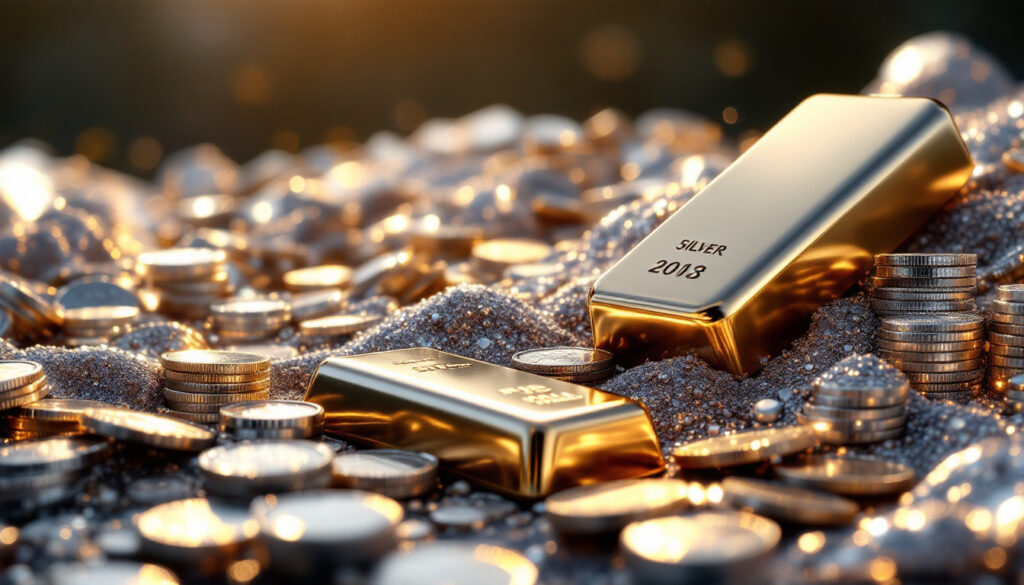What Causes Silver Price Fluctuations?
Recent Market Anomalies in Silver
Silver prices have demonstrated unprecedented volatility in recent trading sessions, defying traditional market dynamics insights by rising 1.5% ($0.45) to $30.16 while other precious metals, including gold (-1.74%, $2,986.90), platinum, palladium, and rhodium (-$150), experienced significant declines. This anomaly occurred alongside broader market turbulence, with the Dow Jones Industrial Average falling 349 points and crude oil dropping to $61.02. The gold-to-silver ratio narrowed to 99.55, just below the psychologically important 100:1 threshold.
The divergence occurred despite a 0.91% strengthening of the U.S. Dollar Index (DXY) to 103.51, which traditionally inversely correlates with dollar-denominated commodities. This suggests structural shifts in silver's market drivers, potentially tied to its industrial applications in green technologies.
Market analysts noted that silver's performance "defied conventional wisdom," with Summit Metals strategists attributing the anomaly to "speculative positioning in anticipation of Federal Reserve policy shifts." A commodities analyst highlighted that "tariff-related volatility has amplified silver's sensitivity to macroeconomic sentiment."
The false rumor of a 90-day tariff pause temporarily boosted equities before markets corrected, illustrating how unverified news fragments can create short-term dislocations in precious metals markets.
Economic Factors Affecting Silver Prices
U.S. trade tariffs imposed on $200B worth of Chinese goods heightened manufacturing input cost concerns. The S&P 500's 10% quarterly decline signaled growing recession probability among institutional investors.
A Federal Reserve Bank economist observed, "Silver's industrial demand profile makes it uniquely vulnerable to trade policy shocks, but its monetary attributes can provide countercyclical support."
Silver's 60-day rolling volatility spiked to 28%, exceeding its 5-year average of 22%, indicating heightened speculative activity. During the 2018-2019 U.S.-China trade war, silver inventories at COMEX warehouses dropped 15% as manufacturers hoarded physical metal, demonstrating how geopolitical market strategies can affect market dynamics.
Why Is Silver Behaving as a Safe-Haven Asset?
Silver's Dual Nature: Industrial Metal vs. Precious Metal
Industrial applications accounted for 56% of global silver demand in 2023, versus 35% for jewelry and investment. Despite this industrial focus, analysts note silver is currently trading primarily as a safe-haven asset similar to gold – an unusual market behavior as silver typically follows industrial demand patterns.
A Goldman Sachs metals strategist noted, "The AI compute revolution is creating unprecedented demand for silver-containing semiconductor components, making it a hybrid tech-precious metal."
Silver's conductivity (63 × 10^6 S/m) remains unmatched among cost-effective metals, ensuring its role in high-efficiency photovoltaic cells. This property has become increasingly valuable as solar panel manufacturers consumed 105M oz of silver in 2023, up 12% year-over-year.
Tesla's Q2 2023 battery production required 18 metric tons of silver, equivalent to 5% of U.S. monthly industrial consumption. This highlights how emerging technologies are creating robust demand bases that may persist even during economic downturns.
Industrial Demand Creating Support
Global EV production growth (+32% YoY) drove a 28% increase in silver demand from the auto sector. Data center construction boom increased silver use in server components by 15% in 2024.
A Boston Consulting Group analyst stated, "Silver's role in 5G infrastructure and edge computing makes it a critical material for the Fourth Industrial Revolution."
Advanced photovoltaic cells now use 20mg silver per watt, down from 25mg in 2020, demonstrating improved efficiency while still maintaining significant demand volume. Apple's M3 chip series uses silver nanowire interconnects, consuming 0.5g per 300mm wafer.
These sectors remain potentially "recession-proof" compared to traditional industries, as governments worldwide continue to subsidize green energy initiatives and AI development requires significant computing power with silver components regardless of economic conditions.
How Does the Federal Reserve Impact Silver Prices?
Interest Rate Policies and Precious Metals
The Federal Reserve is under increasing pressure to lower interest rates, with Fed Funds futures pricing a 67% probability of a 25bps rate cut by September 2024. The current 10-year TIPS yield of 1.3% (real) reduces the opportunity cost of holding non-yielding silver.
A former Fed Board economist commented, "The Taylor Rule suggests current rates remain 150bps above neutral, creating asymmetric upside for metals if cuts materialize."
Silver's 90-day correlation with 10-year real yields strengthened to -0.78 in Q2 2024, versus -0.65 historical average. This heightened negative correlation underscores how potential rate cuts would likely benefit both gold and silver prices.
The 2013 "Taper Tantrum" provides a historical example where silver prices dropped 26% as real yields spiked 80bps, illustrating the sensitivity of precious metals to unexpected shifts in monetary policy. The upcoming CPI inflation data could significantly impact near-term silver price movement by influencing Fed policy expectations.
Inflation Concerns and Silver Performance
U.S. M2 money supply remains 35% above pre-pandemic trendline despite Fed balance sheet reduction. Cleveland Fed's inflation nowcast suggests 3.1% core CPI for June 2024, feeding the debate over whether inflation has peaked or continues to rise.
A Bridgewater Associates researcher noted, "Silver's dual demand profile makes it more responsive to inflation surprises than gold."
Since 1913, the dollar has lost 97% of purchasing power, while silver has appreciated 4.8% annualized in real terms. This long-term perspective reinforces silver's historical role as an inflation hedge.
During 1974-1982 stagflation, silver outperformed gold with 1,200% nominal return vs. gold's 450%. This suggests that in inflationary environments, particularly those accompanied by economic stagnation, silver can exhibit extraordinary performance due to its monetary properties.
What Technical Indicators Are Silver Investors Watching?
Gold-to-Silver Ratio Analysis
The current gold-to-silver ratio of 99.55 compares to a 10-year average of 78:1 and an all-time average of 40:1. Since 2000, ratio extremes above 80:1 preceded silver rallies averaging 48% over 18 months.
A Citigroup technical strategist stated, "The ratio's 200-week moving average at 85:1 represents key support for silver bulls."
Mean reversion trades using the ratio require 4:1 gold/silver futures contract sizing to maintain dollar equivalency. In 2011, the ratio bottomed at 31.5:1 during silver's $49.50 peak, illustrating how far the pendulum can swing during silver bull markets.
The narrowing ratio potentially signals silver outperformance relative to gold. Investors monitor this metric for potential mean reversion opportunities, as historical ratio averages suggest silver may be significantly undervalued compared to gold at current levels.
Price Volatility Patterns
Silver's 20-day historical volatility reached 38% in June 2024 vs. gold's 22%. Open interest in COMEX silver options increased 42% YoY, reflecting heightened hedging demand.
A CBOE volatility trader noted, "Silver's volatility skew shows increasing demand for $40 strike calls, suggesting speculative positioning."
The Bollinger Band Width (20,2) on silver prices reached 0.32, exceeding the 90th percentile volatility since 2000. This technical indicator suggests possible continued fluctuation as silver experiences "heightened volatility" since the previous week.
March 2024's "Silver Squeeze" saw 10% daily price swings amid Reddit-fueled retail trading activity. These short-term price movements are often driven by emotional market reactions, creating potential for profit-taking following unexpected price increases.
How Should Investors Approach Silver in Current Market Conditions?
Physical Silver vs. ETF Investment Strategies
Physical silver premiums averaged 18% over spot in Q2 2024 vs. 12% for gold. SLV ETF holdings declined 7% YTD as investors shifted to allocated storage solutions.
A Brink's Global Services executive stated, "High-net-worth investors are increasingly opting for non-bank vaulting solutions with 100% allocated metal."
The London Bullion Market Association's (LBMA) trade reporting shows 68% of 1000oz bar trades settled within 0.5% of spot, indicating liquid physical markets. However, during the March 2020 liquidity crisis, ETF shares traded at an 8% discount to NAV while physical premiums spiked to 35%.
Physical silver ownership provides direct possession and an economic hedge, while gold ETF strategies offer more liquidity but are subject to market volatility. Many analysts recommend maintaining physical holdings through market turbulence, with current price levels ($30/oz range) potentially attractive for accumulation.
Long-Term Investment Perspective
Silver mining all-in sustaining costs (AISC) averaged $18.50/oz in 2023 vs. $16.80 in 2020. Identified silver resources total 560,000 metric tons, equal to 22 years of current production.
A Sprott Asset Management PM commented, "Silver's critical mineral status in multiple jurisdictions creates structural supply constraints."
The silver-gold production ratio has fallen from 8:1 in 2000 to 6:1 today, reflecting declining silver mine yields. Pan American Silver's 2023 reserve replacement ratio fell to 65%, highlighting depletion challenges in the industry.
The importance of patience and persistence during market volatility cannot be overstated. While the rise and fall of silver prices will continue to fluctuate in the short-term, long-term fundamentals remain supportive for precious metals, creating opportunities to "buy the dip" for those with available investment capital.
FAQ About Silver Price Movements
Why did silver rise when gold fell?
Silver demonstrated unusual market behavior by rising 1.5% while gold fell 1.74%, suggesting investors temporarily viewed silver as a safe-haven asset rather than primarily an industrial metal. This divergence reflects shifting perceptions of silver's monetary properties during periods of heightened economic uncertainty and trade tensions.
What is the gold-to-silver ratio and why does it matter?
The gold-to-silver ratio (currently 99.55) represents how many ounces of silver it takes to purchase one ounce of gold. Investors use this ratio to identify potential value opportunities between the two metals. When the ratio is significantly above historical averages, as it is now, many analysts interpret this as a signal that silver may be undervalued relative to gold, potentially leading to outperformance.
How do Federal Reserve policies impact silver prices?
Interest rate decisions directly affect precious metals, with lower rates typically supporting higher silver prices by reducing the opportunity cost of holding non-yielding assets. The correlation between silver prices and real yields has strengthened in recent quarters, making Fed policy announcements particularly impactful for silver market movements. Additionally, monetary policy influences inflation expectations, which drive investment demand for silver as a store of value.
What industrial sectors drive silver demand?
Key industrial demand comes from electric vehicles, solar energy, consumer electronics, and AI computing infrastructure, all of which require silver for their manufacturing processes. EV production uses silver in battery management systems and electrical contacts, while photovoltaic cells remain one of the largest industrial consumers. The semiconductor industry increasingly relies on silver for high-performance computing applications, creating a robust demand base less susceptible to economic cycles than traditional industrial uses.
Understanding investment vs. speculation is crucial when navigating silver markets, as short-term price movements can be volatile. For investors interested in broader resource exposure, a mining stocks guide can provide valuable context on how silver producers fit within the commodities landscape. Additionally, analyzing historical silver prices can offer perspective on current market conditions and potential future movements.
Are You Monitoring Opportunities in Mining Discoveries?
Don't miss the next major mineral discovery on the ASX. Discovery Alert's proprietary Discovery IQ model instantly transforms complex mineral data into actionable investment insights, giving you a crucial market advantage. Explore how historic discoveries have generated substantial returns by visiting the Discovery Alert discoveries page and start your 30-day free trial today.




